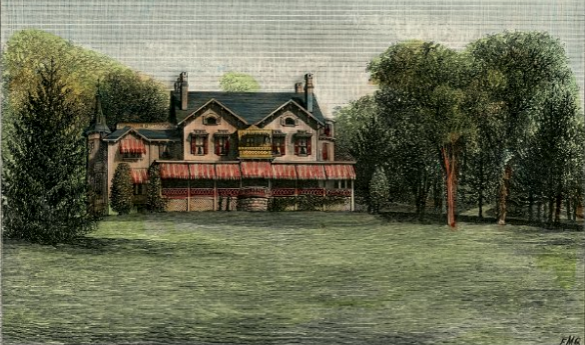Woodcliff: Home to a Morgan and Irvington founder
 |
This is an illustration of how George D. Morgan’s Woodcliff mansion appeared in the late 1890s. (Westchester County Historical Society) |
"Woodcliff" stood at today's 76 North Broadway, Irvington, and was the home of a man closely linked to America’s leading banking family and the Lincoln administration during the height of the Civil War.
George Denison Morgan (1818-1891) was one of Irvington’s earliest estate owners. A brother-in-law of Civil War and Reconstruction-era U.S. Navy Secretary Gideon Welles and relative of legendary financier John Pierpont Morgan -- J.P. Morgan -- George D. Morgan was already living at Woodcliff when the village was born as Dearman in 1850.
George D. Morgan was variously identified in stories of the day as J.P. Morgan’s cousin, uncle or brother. In reality, he was a distant cousin of the famed financier, and two of George D.'s sons married J.P. Morgan’s sisters, tightening the family bonds.
J.P. Morgan’s son J.P. Jr. -- “Jack” -- was born at George D. Morgan’s Irvington estate on Sept. 7, 1867. A story in The Irvington Gazette newspaper of Aug. 23, 1951 stated that George D. Morgan and J.P. Morgan Sr. swapped their respective estates in Irvington and Newport, R.I., respectively, during that summer season.
 |
J.P. Morgan Sr. (left) and his son J.P. Jr. -- “Jack” -- are pictured together in 1913. Jack Morgan was born at George D. Morgan’s Irvington estate in 1867. (Wikimedia Commons) |
George Morgan, later an official with the Equitable Life Assurance Society of the United States, led the charge along with fellow Dearman resident U.S. Rep. Moses H. Grinnell to change the name Dearman in 1854 to Irvington to honor famed author and area resident Washington Irving, a personal friend of Morgan’s.
At the time, Edwin D. Morgan was president of the Hudson River Railroad and obliged George D. Morgan’s request to change the name of the train station to Irvington. Grinnell was granted a similar request for the local Post Office by the U.S. Postmaster General.
Morgan and Irving in 1853 had become trustees and investors in Westchester’s first savings bank, based in Tarrytown -- Westchester County Savings Bank.
At the outset of the Civil War, Navy Secretary Welles employed his brother-in-law Morgan as a purchasing agent for the Navy, the first step of what would become a scandal when Morgan was ordered to buy old and retired ships to augment the Navy’s blockade of Southern ports. Morgan would collect a 2.5 percent commission on each sale and made a quick fortune doing so, including for ships that were not particularly seaworthy -- two of them sank shortly after arriving off the coast of Charleston, S.C.
On July 24, 1863, Welles was dissuaded from visiting the Morgans in Irvington when Morgan wrote to him referring to potential problems regarding military draft controversies at the time. “[Irvington] is a hard democratic section full of Irish laborers who are bitterly opposed to the draft and the leaders here are as bad as in [New York City].”
Immigrant laborers were particularly hard hit by the Abraham Lincoln administration’s new federal draft laws in 1863 since the law allowed wealthy draftees to buy their way out of service for a payment of $300 -- some $6,300 today -- the average annual income of a laborer. Thus workers were compelled to go to war, the wealthy were not. The controversy led to five days of deadly rioting in New York in July 1863.
Fearing that the violence in the city, which had to be put down by Federal troops, would spread to Westchester, special police were brought in and quartered in a schoolhouse on Sunnyside Lane. They were commanded by 75-year-old James Alexander Hamilton, a son of Founding Father Alexander Hamilton, whose estate, Nevis, still stands on South Broadway, Irvington. The presence of the special force kept peaceful a group of draft protesters who passed through the the Town of Greenburgh on its way to Tarrytown.
Morgan’s estate on North Broadway between John Williams’ “Strawberry Hill” manor and Heber R. Bishop’s “Craig Hall” went through a series of private owners including Mason B. Starring Jr. from about 1925 to 1951 until it finally became home to U.S. Time Corporation, a division of Timex, that conducted research on electric eye and missile guidance systems.
Meanwhile, Equitable Assurance owned a property just across North Broadway from Morgan’s estate.
On George D. Morgan’s death, his house became the property of his niece, Anne, sister of J.P. “Jack” Morgan Jr. It was sold several more times before getting a zoning variance in 1956 for the U.S. Time facility.
The Maxon Companies, a third party administrator of health benefit packages, occupies the old George D. Morgan estate site today.
The property lies just east of North Broadway, immediately north of Strawberry Lane.
 |
This is an 1891 map showing the 72-acre George Denison Morgan estate “Woodcliff.” The street in light red running vertically to the left of the estate is North Broadway. Sunnyside Lane runs from west to east across the top of the map and the estate reaches as far East as Peter Bond Road (right). (Frederick W. Beers, 1891, David Rumsey Map Collection) * Click here for links to dozens of other Gilded Age stories by this author |











This comment has been removed by a blog administrator.
ReplyDelete